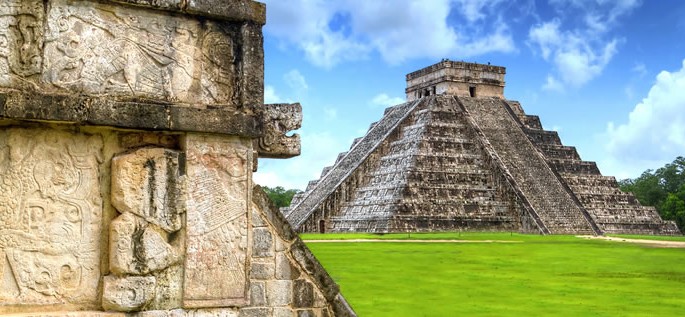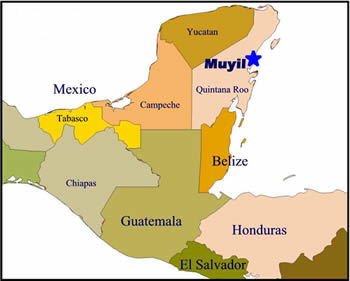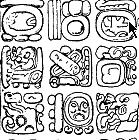
Mayan Language Family
The Mayan language family is a group of 69 related languages spoken by some 6 million people in Central America. These languages are thought to have originated from a common ancestral language called Proto-Mayan which was spoken at least 5,000 years ago by inhabitants of the Mayan empire whose remains can be found throughout much of Guatemala, Belize, Honduras, El Salvador and southern Mexico.
The empire flourished for many hundreds of years from 1,500 BC, but collapsed during the period 800-900 AD.
Today, the largest populations of Maya speakers can be found in the Mexican states of Yucatán, Campeche, Quintana Roo, Tabasco, and Chiapas, and in the Central American countries of Belize, Guatemala, and the western portions of Honduras and El Salvador.

The table below, based on Ethnologue, lists the main branches, their member languages, number of speakers, and geographical distribution. In recent years, the names of some Mayan languages have been changed in order to more accurately represent their pronunciations and to remove the Spanish spelling patterns imposed on their orthographies by earlier missionaries. The alternate spellings are given in parentheses.
|
|||||||||||||||||||||||||||||||||||||||||||||||||||||||||||||||||||||||||||||||||||||||||||||||||||||||||||||||||||||||||||||||||||||||||||||||||||||||||
Status
Although Spanish is the official language of all Central American countries (except for Belize, where it is English), many Mayan languages are still spoken today as first or second languages by over six million indigenous people. Although still spoken by relatively large populations, Mayan languages show signs of language shift (i.e., replacement by Spanish) and decline because the children in many communities are no longer learning the language of their parents. At the same time, Mayas are participating in a language revitalization movement which will hopefully result in preventing further decline of these languages.
Dialects
Most Mayan languages have more than one variety, e.g., Cakchiquel (10 varieties), Tzotzil (6 varieties), Mam (5 varieties), Ixilan (4 varieties).
Structure
Sound system
Below are some characteristic features of the sound systems of Mayan languages.
Vowels
- Most Mayan languages have five vowel phonemes, i.e., sounds that make a difference in word meaning: /i, e, a, u, o/.
- Vowels can be long or short. Vowel length distinguishes the meaning of otherwise identically-sounding words.
- Many languages have nasalized vowels.
Consonants
- Most Mayan languages lack the sounds /b/, /d/, /g/, /z/.;
- Glottalized, ejective and implosive consonants are fairly common.
Tones
A few Mayan languages have tones, for example Yucatec Maya.
Grammar
Mayan languages are ergative, i.e, the subject of a transitive verb appears in the ergative case, while the subject of an intransitive verb is represented by a different form — the same form as the object of a transitive verb (the absolutive case).
Nouns and pronouns
- Nouns in most Mayan languages are not marked for case, but a wide variety of prepositions is used to express various functions. For example, in Yucatec Maya, possession is marked by the preposition u preceding the object possessed, e.g, u pekoob Pedro ‘Pedro’s dogs.’
- Gender is usually not explicitly marked. However, if needed, it can be marked by the prefixes in the case of animate nouns. Inanimate nouns have no gender distinction.
- The plural is commonly formed by adding the suffixes, e.g., in Yucatec Maya,the suffix –oob is added to nouns, e.g., pek ‘dog,’ pekoob ‘dogs.’ There are other suffixes, e.g., ac ‘turtle,’ aci ‘turtles.’
- Mayan languages have no articles, but a demonstrative particles can be used instead.
- Some Mayan languages have noun classifiers.
- Many Mayan languages make a distinction between inclusive vs. exclusive 1st person plural pronouns, i.e., one that includes and one that excludes the interlocutor.
Verbs
Mayan verb systems are quite complex. These systems evolved from ancestral Proto-Mayan which had seven tense/aspect/mood combinations
- Mayan verbs are marked for the person and number of the subject in the case of intransitive verbs, or the person of the object in the case of transitive verbs.
- Tense systems in Mayan languages are generally simple. Jakaltek has only two tenses: past and non-past, while Mam has only future and non-future.
- Most Mayan languages have relatively complex aspect systems featuring various affixes for marking aspectual distinctions.
- Mood does not usually constitute a separate system. Rather, it is intertwined with the tense/aspect system.
- Mayan languages tend to have a rich set of grammatical voices, such as the following:
antipassive voice which deletes or demotes the object of transitive verbs, and promotes the actor to an intransitive subject. This voice is very common among ergative languages.
mediopassive which subsumes the meanings of both the middle voice and the passive voice.
Particles
Mayan languages make extensive use of particles. There may be over one hundred different particles in all Mayan languages.
Word order
Mayan languages differ in their basic word order. For example, Yucatec Maya, Tzotzil and Tojolabal have a basic fixed Verb-Object-Subject word order. Mam, Kanjobal, and Jakalteko have a fixed Verb – Subject – Object order, Chorti has a basic Subject – Verb- Object order. Some Mayan language allow both SOV and SVO word orders.
Vocabulary
The basic vocabulary of Mayan language is Mayan in origin. However, all Mayan languages have borrowed from each other and from Spanish. Word-formation processes include the following:
- compounding of noun roots to form new nouns
- derivation of nouns from verbs
- incorporation of noun stems into verbs
- widespread metaphorical use of roots denoting body parts, particularly to form locatives and relational nouns such as Cakchiquel chi ru-pam ‘inside’ (literally, ‘mouth its-stomach’).
Below are several basic words in four Mayan languages.
|
Yucatec
|
Ch’ol
|
Chontal
|
||
|---|---|---|---|---|
| man |
xiib
|
winik
|
achin
|
winik
|
| woman |
ch’up
|
ixch’up
|
ixöq
|
x’ixik
|
| sun |
k’iin
|
k’in
|
q’ij
|
Ch’ujutat
|
| water |
ha’
|
ja’
|
ya’
|
ja’
|
Man: Winic, Woman: X’ixic, Sun: Ch’ujutat, Water: Ja’. Below are the numerals 1-10 in four Mayan languages.
|
.
|
1
|
2
|
3
|
4
|
5
|
6
|
7
|
8
|
9
|
10
|
|---|---|---|---|---|---|---|---|---|---|---|
|
inte
|
chate
|
ushte
|
chante
|
jote
|
wac’te
|
uc’te
|
washic’te
|
boronte
|
launte
|
|
|
jun
|
cab
|
osheb
|
caneb
|
oyeb
|
waqeb
|
uqeb
|
washaqeb
|
baloneb
|
lajoneb
|
|
|
hun
|
cab
|
ox
|
cah
|
oo
|
vacac
|
vucub
|
vahxac
|
beleh
|
lahuh
|
|
|
Yucatec Maya
|
hun
|
ka’a
|
óox
|
kan
|
ho
|
wak
|
uk
|
waxak
|
bolon
|
lahun
|
Writing
The pre-Columbian Maya civilization developed a writing system that represented the language of the Maya people as it was spoken at that time and known today as Classical Maya. The earliest Mayan inscriptions date back to the 1st century BC. The script was in continuous use up until shortly after the arrival of the Spanish conquistadors in the 16th century AD. Although many documents were written in Maya hieroglyphics at the time of the Spanish conquest of the Yucatán in the 16th century, they were destroyed by the conquistadors and priests. As a result, our knowledge of the ancient Maya is very fragmentary since of the thousands of books, only four have survived destruction. Knowledge of the writing system was lost, probably by the end of the 16th century. Renewed interest in it was sparked by published accounts of Maya ruins in the 19th century.
The decipherment of the Maya writing was a long and laborious process. 19th and early 20th century investigators managed to decode Maya numbers and portions of the text related to astronomy and the Maya calendar, but understanding of most of the rest long eluded scholars. While the decipherment of Maya hieroglyphs has been advancing rapidly in the past few decades, differing opinions as to whether or not Maya writing consisted of logographs (word-pictures) or of symbols representing sounds of the language. Finally, in the mid-twentieth century, Tatiana Proskouriakova, a Russian Mayanist, demonstrated that the Maya hieroglyphics were a fully functional system of close to 800 symbols, each representing a syllable consisting of a consonant and one of the five vowels:/i/, /e/, /a/, /o/, /u/.
Click here to see the Mayan syllabary.
Almost no literature in Mayan languages was written in the postcolonial period (after 1821), except by linguists and ethnographer who recorded oral Mayan literature. By and large, the Mayan peoples had remained largely illiterate in their native languages, some of them becoming literate in Spanish. Since the 1980’s, however, native language literacy has begun to spread and a number of indigenous writers have started a new tradition of writing in Mayan languages. Notable among this new generation is the K’iche’ poet Humberto Ak’ab’al, whose works are often published in dual-language Spanish/K’iche’ editions.
Today, Mayan languages are written with adapted versions of the Latin alphabet. Formerly spelling was generally based on Spanish, and it is only recently that standardized orthographic conventions have started to arise. The first widely-accepted orthographic standards were developed for Yucatec Maya in 1980. Subsequently, the Guatemalan Academy of Mayan Languages adapted these standards to other Mayan languages of Guatemala.
Take a look at the text of Article 1 of the Universal Declaration of Human Rights in three Mayan languages. As you can see, there are no similarities in the vocabulary. This is due to the fact that these languages have split from a common ancestor very long ago and have had little or no contact with each other.
|
Tneejal tiipaky’ (1) |
|
Artículo 1 |
|
Huastec (San Luis Potosi) K’a’ál tsalap (art. 1) |
| K’iche’Nab’e taqanik (1) Konojel ri winaq are taq ke’alaxik pa junaman ya’tal chkech kakechab’ej ronojel ri utzil; utz kakib’ano, kakichomaj, kakib’ij jasa je’ ri k’o pa kanima, rumal che ri junam kib’antajik. Rajawaxik xuqe’ kakimulij kib’ che utzukuxuk ri loq’ob’al pa we uwachulew. |
| English All human beings are born free and equal in dignity and rights. They are endowed with reason and conscience and should act towards one another in a spirit of brotherhood. |
Difficulty

There is no data on the difficulty of Mayan languages for speakers of English.
